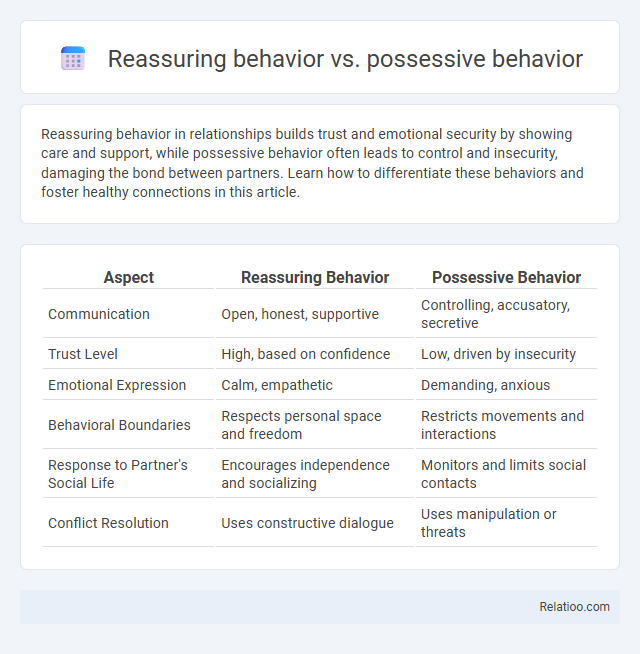Reassuring behavior in relationships builds trust and emotional security by showing care and support, while possessive behavior often leads to control and insecurity, damaging the bond between partners. Learn how to differentiate these behaviors and foster healthy connections in this article.
Table of Comparison
| Aspect | Reassuring Behavior | Possessive Behavior |
|---|---|---|
| Communication | Open, honest, supportive | Controlling, accusatory, secretive |
| Trust Level | High, based on confidence | Low, driven by insecurity |
| Emotional Expression | Calm, empathetic | Demanding, anxious |
| Behavioral Boundaries | Respects personal space and freedom | Restricts movements and interactions |
| Response to Partner's Social Life | Encourages independence and socializing | Monitors and limits social contacts |
| Conflict Resolution | Uses constructive dialogue | Uses manipulation or threats |
Understanding Reassuring vs Possessive Behavior
Understanding reassuring behavior involves recognizing actions that provide comfort, support, and security in relationships, fostering trust and emotional safety. Possessive behavior, however, manifests as controlling, jealous, or intrusive actions aimed at dominating a partner, often leading to tension and reduced autonomy. Differentiating these behaviors is crucial for maintaining healthy boundaries and promoting mutual respect in interpersonal dynamics.
Key Characteristics of Reassuring Behavior
Reassuring behavior is characterized by consistent support, calm communication, and empathy that fosters trust and security in relationships. Unlike possessive behavior, which often involves control and jealousy, reassuring behavior promotes independence and emotional safety. Your ability to provide reassurance helps build a foundation of mutual respect and understanding.
Key Traits of Possessive Behavior
Possessive behavior is characterized by controlling actions, excessive jealousy, and a constant need for validation from a partner, often leading to distrust and insecurity within relationships. Unlike reassuring behavior, which fosters comfort and confidence, possessiveness can stifle personal freedom and create an oppressive environment. Key traits include monitoring a partner's interactions, restricting social activities, and reacting negatively to perceived threats, all of which undermine healthy communication and mutual respect.
Emotional Impact on Relationships
Reassuring behavior fosters trust and emotional security by consistently validating partner feelings, which strengthens relationship bonds and reduces anxiety. Possessive behavior often triggers insecurity and fear, leading to emotional withdrawal or conflict due to perceived control or jealousy. Balancing reassurance with healthy boundaries promotes mutual respect and emotional stability, essential for long-term relationship satisfaction.
Healthy Boundaries: Reassurance vs Possessiveness
Healthy boundaries in relationships distinguish between reassuring behavior, which fosters trust and security, and possessive behavior, which often stems from insecurity and control. Reassuring behavior encourages open communication and respects your autonomy, while possessiveness may manifest as jealousy, monitoring, or restricting your interactions. Maintaining clear boundaries ensures reassurance builds connection without crossing into possessive control.
Signs You’re Being Reassuring, Not Possessive
Signs you're being reassuring, not possessive include respecting personal boundaries, showing trust through open communication, and providing emotional support without constant monitoring or controlling actions. Reassuring behavior promotes a healthy relationship by encouraging independence and mutual respect, whereas possessive behavior often involves jealousy, suspicion, and attempts to limit a partner's freedom. Clear, empathetic communication differentiates reassurance from possessiveness, ensuring both partners feel valued and secure.
Warning Signs of Possessive Behavior
Warning signs of possessive behavior include excessive jealousy, constant monitoring of your activities, and isolating you from friends or family. This controlling behavior often stems from insecurity and may escalate to emotional manipulation or intimidation. Recognizing these red flags early helps protect your mental well-being and maintain healthy, respectful relationships.
Communication Styles in Each Behavior
Reassuring behavior in communication emphasizes empathy, active listening, and affirming messages to create trust and emotional safety. Possessive behavior often manifests through controlling language, interruptions, and withholding information, signaling insecurity and dominance. Assertive communication balances expressing one's needs clearly while respecting others' boundaries, promoting mutual understanding and healthy interactions.
How to Foster Healthy Reassurance
Fostering healthy reassurance involves recognizing the difference between supportive reassurance and possessive behavior, as possessiveness can undermine trust and independence. You can encourage open communication and consistent emotional support that validates feelings without controlling actions or fostering dependency. Establishing clear boundaries and mutual respect helps maintain a secure and balanced relationship dynamic.
Steps to Address and Avoid Possessiveness
Steps to address and avoid possessiveness involve setting clear personal boundaries, encouraging open communication, and fostering mutual trust within your relationship. Reassuring behavior supports emotional security by expressing appreciation and understanding, contrasting possessive behavior that often stems from insecurity and control. You can cultivate a healthy dynamic by regularly practicing empathy and addressing insecurities before they escalate into possessiveness.

Infographic: Reassuring behavior vs Possessive behavior
 relatioo.com
relatioo.com